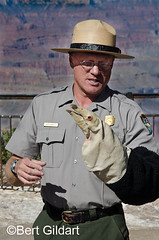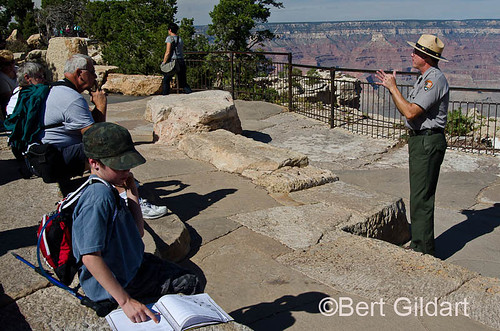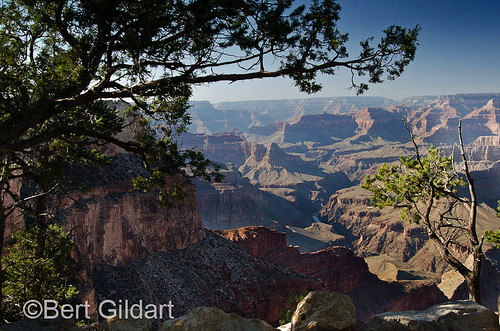Hope for the Endangered California Condor? Maybe
©Bert Gildart: While standing at Mather Overlook, one of the most beautiful natural amphitheaters in the world, Ranger/Naturalist Marty Martell provided an informative lecture on the huge California Condor. He described the vast populations that existed up until the late 1800s, enumerated the reasons for the gigantic bird’s sudden decline – and described the efforts various organizations have employed to save the species from extinction.
The lecture was an appropriate park presentation as the nearby Vermillion Cliffs serve as one of the release sites. Often, then, the cliffs in and around Mather Overlook provide favorite roosting areas.
DECLINE
California condors have the distinction of being the nation’s largest bird, with a wing span that stretches about nine feet from tip to tip. Sporting a squat, bald head, mumps-like cheeks, and a thick powerful beak, condors also have the distinction of being one of the ugliest of birds. Until recently they served the ecosystem by cleaning the landscape of dead carcasses, and did so until settlers began making their way across country in the mid 1800s.
Sometimes settlers shot the birds, but they also grabbed the huge egg that condors lay but once every several years. Then, to compound matters, along came the use of DDT, introduced in the 1960s as a pesticide. The substance worked its way into the ecosystem, weakening condor eggs to such an extent that by 1985, the nation tallied but 21 birds.
In an attempt to rescue them from extinction, California biologists began a captive breeding program.
HEROIC MEASURES
Ranger Martell said that the program initially encountered problems because the birds would imprint on the person who was trying to raise them. He said the problem was resolved by disguising the “parent” in such a way that he or she would look like a condor. Researcher also had to condition young birds to avoid electrical power poles. They did so by placing power poles loaded with uncomfortable charges in the huge pens where condors were developing. “After landing on one a time or two you can bet they’d avoid them in the wild.”
Very slowly the program began to work, and though a population requires thousands before the species can be removed from the endangered list, today the nation’s population numbers 435 with about 70 of those birds residing in and around Arizona’s Grand Canyon. Others reside in Baja California and in California’s spectacular Anza Borrego Desert State Park (ABDSP).
Often visitors see condors while in the Grand Canyon, though we didn’t. But good news looms. We’re now in ABDSP, and have just read that on November 23, Dr. Mike Wallace will be providing a presentation on his work with condors at this state park’s annual desert lecture series.
We’ll certainly be attending, hoping we can learn more about the bird that has so fascinated Grand Canyon naturalist Marty Martell. Anza Borrego, incidentally, will be our home for the next few months.
——————————————–
AIRSTREAM TRAVELS TWO YEARS AGO:
*Shenandoah’s Loft Mountain Campground
ADS FROM AMAZON AND GOOGLE AUGMENT OUR TRAVELS:
(You can order our new books (shown below ) from Amazon — or you can order them directly from the Gildarts. Bert will knock a dollar off the list price of $16.95, but he must add the cost of book-rate mailing and the mailer, which are $2.25. The grand total then is $18.20. Please send checks to Bert Gildart at 1676 Riverside Road, Bigfork, MT 59911.)




